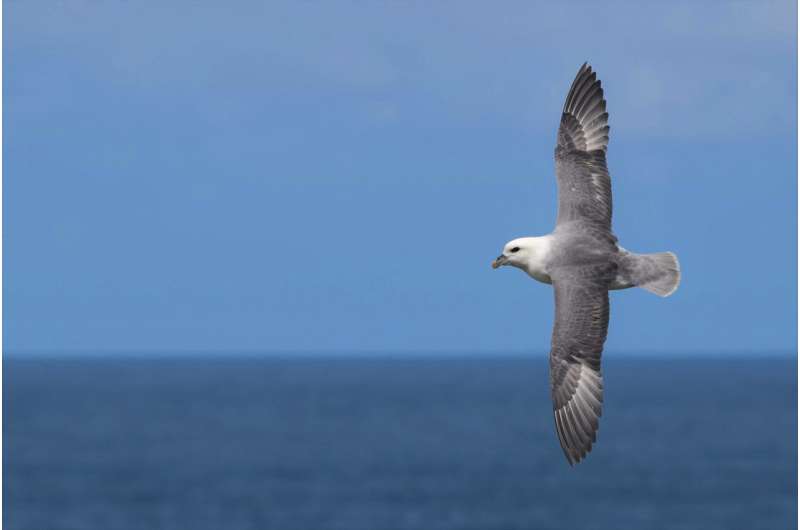
Northern Fulmar in flight. Source: Beth Clark
An analysis of global tracking data for 77 species of petrel revealed that a quarter of all plastic they may encounter in their search for food is in remote international waters—which requires international collaboration to address.
The extensive study examined the movements of 7,137 individual birds from 77 species of petrel, a group of widely migratory seabirds including the Northern Fulmar and European Storm-petrel, and the Critically Endangered Newell’s Shearwater.
This is the first time that tracking data for so many seabird species has been combined and overlaid into global maps of plastic distribution in the oceans.
The results show that plastic pollution threatens marine life on a scale that transcends national borders: a quarter of all plastic exposure risks occur in the high seas. This is largely related to gyres—large systems of rotating ocean currents—where large concentrations of plastics form, fed by trash entering the ocean from boats, and from many different countries.
Seabirds often mistake small pieces of plastic for food, or eat plastic that has already been eaten by their prey. This can cause injury, poisoning and starvation, and petrels are particularly vulnerable because they cannot regurgitate the plastic easily. During the breeding season they often accidentally feed plastic to their chicks. Plastics can also contain toxic chemicals that can harm seabirds.
Petrels are an understudied but vulnerable group of marine species, which play an important role in ocean food webs. The extent of their distribution throughout the ocean makes them important “sentinel species” when assessing the risks of plastic pollution in the marine environment.
“Ocean currents cause huge swirling collections of plastic waste to pile up far from land, out of sight and beyond the jurisdiction of any country. We found that many petrel species spend a lot of time feeding around this mid-ocean, which puts them at high risk of ingesting plastic debris,” said Lizzie Pearmain, a Ph.D. student in the Department of Zoology at the University of Cambridge and the British Antarctic Survey, and joint corresponding author of the study.
He added, “When petrels eat plastic, it can get stuck in their stomachs and feed to their chicks. It leaves little space for food, and can cause internal damage or release toxins.”
Petrels and other species are already at risk of extinction due to climate change, bycatch, competition from fisheries, and invasive species such as mice and rats in their breeding colonies. Researchers say exposure to plastics may reduce birds’ resilience to these other threats.
The northeast Pacific, South Atlantic, and southwest Indian oceans have mid-oceans filled with plastic debris, where many threatened species of seabirds forage.
“Even species with a low risk of exposure have been found to ingest plastic. This shows that levels of plastic in the oceans are a problem for seabirds around the world, even outside of these high-altitude areas exposure,” said Dr. Bethany Clark, Seabird Science Officer at BirdLife International and joint corresponding author of the study.
He added, “Many petrel species are at risk of being exposed to plastic in the waters of many countries and in the oceans during their migrations. to tackle plastic pollution in the world’s oceans.”
The study also found that the Mediterranean Sea and the Black Sea together account for more than half of the petrel’s global plastic exposure risk. However, only four species of petrel forage in these closed, busy areas.
The study was led by a partnership between the University of Cambridge, BirdLife International and the British Antarctic Survey, in collaboration with Fauna & Flora International, the 5 Gyres Institute, and more than 200 seabird researchers in 27 countries. It was published in the journal Communication in Nature.
To obtain their results, the researchers overlaid global location data, taken from tracking devices attached to the birds, onto previous maps of marine plastic distribution. This allows them to identify bird migration sites and find routes where they are likely to encounter plastics.
Species are given an “exposure risk score” to indicate their risk of encountering plastic during their time at sea. Several of the already threatened species scored highly, including the Critically Endangered Balearic Shearwater, which breeds in the Mediterranean, and the Newell’s Shearwater, endemic to Hawaii.
Another Endangered species, the Hawaiian Petrel also scores high for the risk of plastic exposure, as do three species classified by the IUCN as Vulnerable: the Yelkouan Shearwater, which breeds in the Mediterranean; The Cook’s Petrel, which breeds in New Zealand, and the Spectacled Petrel, which breeds only on an extinct volcano called Inaccessible Island, part of the Tristan da Cunha archipelago, a UK Overseas Territory.
“While the population-level effects of plastic exposure are still unknown for most species, many petrels and other marine species are already in an endangered state. at Cambridge’s Department of Zoology, is a co-author of the study.
He added, “This study is a huge leap forward in understanding the situation, and our results will feed into conservation work to try and address threats to seabirds.”
More information:
Bethany Clark, Global risk assessment of marine plastic exposure for seabirds, Communication in Nature (2023). DOI: 10.1038/s41467-023-38900-z. www.nature.com/articles/s41467-023-38900-z
Provided by the University of Cambridge
Citation: Most threatened seabirds visit remote plastic pollution hotspots, study finds (2023, July 4) retrieved 4 July 2023 from https://phys.org/news/2023-07-world- threatened-seabirds-remote-plastic.html
This document is subject to copyright. Except for any fair dealing for the purpose of private study or research, no part may be reproduced without written permission. Content is provided for informational purposes only.
